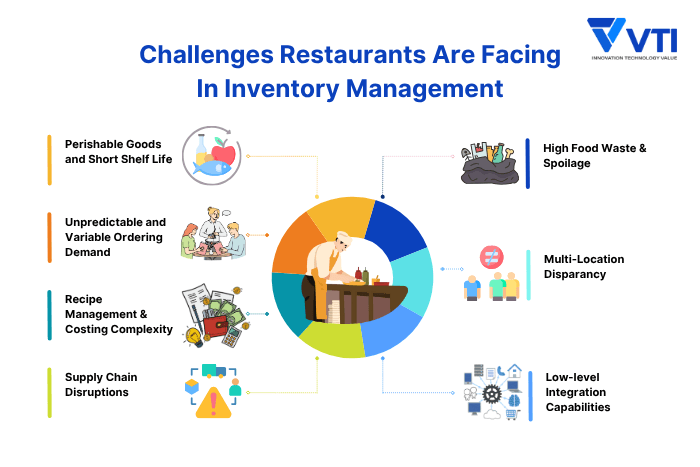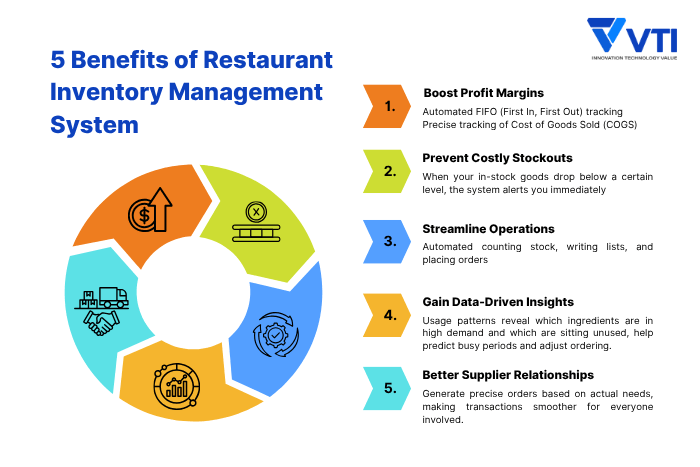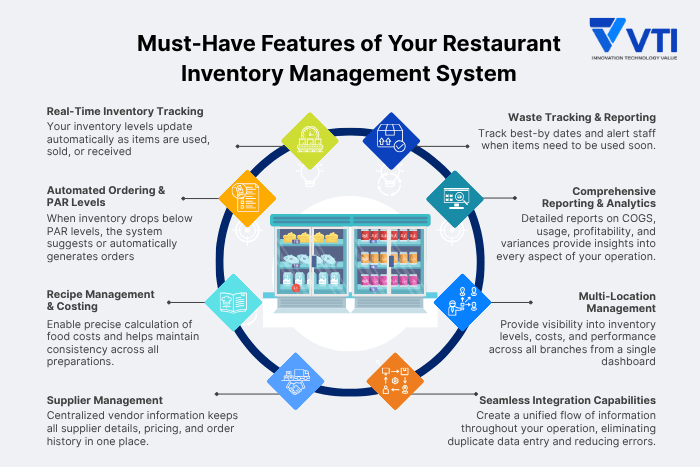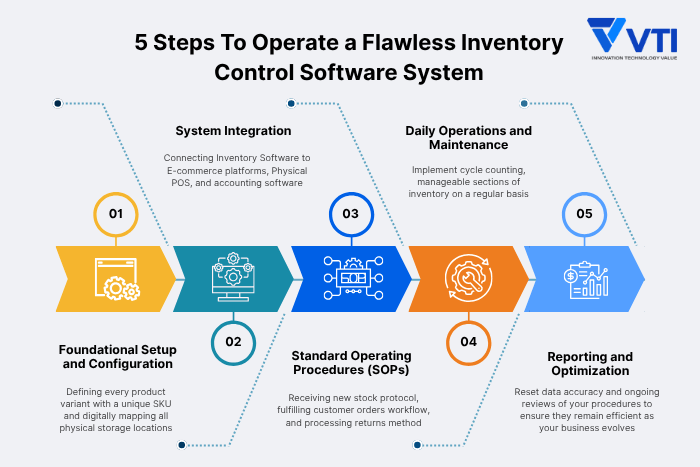“I was losing sleep over inventory,” shares Maria Santos, owner of a popular ramen chain in Singapore. “One week we’d run out of our best-selling broth, the next week we’d throw away pounds of unused ingredients. It felt like throwing money straight into the trash.” Maria’s story isn’t unique. Across the Asia Pacific, restaurant owners are watching their hard-earned profits vanish through poor restaurant inventory management. But here’s the good news: it doesn’t have to be this way.
In this comprehensive guide, we’ll cover why these systems are crucial for your bottom line, essential features to look for, and how to implement best practices that actually work. Ready to transform your inventory chaos into profit-generating control? Let’s dive in.
What is Restaurant Inventory Management?
Restaurant Inventory Management is the process of tracking, ordering, storing, and using a restaurant’s ingredients and supplies. It ensures that the right amount of food, beverages, and other necessary items are available to meet customer demand without overstocking or wasting resources.
Like being the conductor of a complex orchestra, you’re coordinating the flow of ingredients, supplies, and finished products to create perfect harmony between what you have, what you need, and what you serve.
At its core, restaurant inventory management involves tracking, controlling, and optimizing all the food, beverages, and supplies that flow through your restaurant. It’s about knowing exactly what you have, where it is, when you’ll run out, and when to reorder.
But here’s where it gets interesting: a dedicated traditional restaurant inventory management takes this basic concept and supercharges it with high-tech system. Then, this smart restaurant inventory management system predicts demand, automates ordering, calculates exact food costs, and gives you insights that can transform your entire operation.
What Challenges are Restaurants Facing in Inventory Management?

Perishable Goods and Short Shelf Life
Perishable goods such as fresh produce, meats, seafood, and dairy products pose significant inventory challenges due to their short shelf life and high risk of spoilage. Over-ordering these items can result in substantial waste and financial loss.
Temperature control is equally critical, as even minor fluctuations in refrigerators, freezers, or dry storage can accelerate spoilage and compromise food safety.
Unpredictable and Variable Ordering Demand
As mentioned, fluctuations based on day of the week, time of day, weather, local events, holidays, reviews, and even viral social media trends directly impact what customers order and how much.
On top of this, the menu mix is constantly evolving. A new dish might suddenly become a customer favorite, leading to a sharp rise in demand for its ingredients, while others may decline in popularity.
Adding to the challenge is ingredient interdependency – common ingredients like chicken may be used across multiple menu items, meaning their total usage depends on the varying popularity of each dish. This makes forecasting and ordering far more complicated than simply tracking individual item sales.
Recipe Management & Costing Complexity
Managing ingredients in a restaurant requires a high level of granularity and precision. It’s not enough to track general categories like “chicken” – restaurants must differentiate between parts like breasts, thighs, and wings, and often manage them by weight, unit count, or cost per serving.
Adding to the complexity, ingredient prices can fluctuate due to seasonality, supply chain disruptions, or changes in market demand, which can quickly erode dish profitability if not monitored closely.
Accurate yield calculations are also essential; knowing how much usable product remains after trimming or prep is crucial for cost control but often relies on manual tracking or is overlooked altogether.
Supply Chain Disruptions
Supply chain unpredictability is a major hurdle in restaurant inventory management. Lead times can vary drastically due to global events, natural disasters, geopolitical tensions, or internal issues within a supplier’s operation, making it difficult to reorder stock with confidence.
Supplier reliability is another concern – poor communication or inconsistent delivery performance can disrupt kitchen operations and lead to menu shortages.
Additionally, increased competition for raw materials or finished goods can cause shortages and drive up prices, especially during peak seasons or supply chain disruptions. Managing multiple suppliers, each with their own delivery timelines, minimum order quantities, and pricing structures, adds further complexity.
High Food Waste & Spoilage
Food waste remains a critical issue in the restaurant industry, with significant financial and environmental implications. Globally, the foodservice sector contributes heavily to food waste, and studies suggest that for every dollar a restaurant invests in food-waste reduction, it can yield up to $14 in additional revenue.
Much of this waste stems from operational inefficiencies such as over-preparation, inconsistent portioning, and inaccurate demand forecasting. Improper storage and handling – due to lack of training or poor adherence to FIFO/FEFO practices – can also cause ingredients to spoil prematurely.
In the kitchen, excessive trim from poor butchery or produce preparation adds to the waste stream, while customer plate waste, though less controllable, still contributes to rising food costs.
Multi-Location Disparancy
Restaurant chains often struggle with maintaining consistent inventory practices and visibility across multiple locations. Each branch may have its own stock levels, usage patterns, and vendor relationships, leading to inefficiencies such as overstocking in one location while another runs out of the same item.
Without a centralized system, it’s difficult for head offices to monitor performance, standardize procedures, or make data-driven decisions. Additionally, managers may lack the flexibility to act quickly if tied to desktop systems or manual paperwork.
Low-level Integration Capabilities
In many restaurants, inventory management operates separately from the POS system, accounting software, or supplier ordering platforms. This disconnect creates inefficiencies, such as the need for manual data entry and reconciliation between systems, which increases the risk of errors and slows down operations.
For example, if inventory levels aren’t automatically updated when a sale is made through the POS, staff may mistakenly reorder items that are actually in stock—or worse, run out of key ingredients during a shift.
Why is Restaurant Inventory Management Important?

Boost Profit Margins: Turn Waste Into Wealth
Food costs typically account for 28–32% of total food sales; even a 1% reduction in food cost can save tens of thousands of dollars annually. However, when inventory is managed manually without accurate tracking, it often results in unnecessary waste – essentially throwing money away.
A robust inventory management system attacks this waste from multiple angles. Take automated FIFO (First In, First Out) tracking for example – your system automatically reminds staff to use older ingredients first, dramatically reducing spoilage. The system also provides precise tracking of your Cost of Goods Sold (COGS). Instead of rough estimates, you get exact costs down to the individual ingredient. This precision allows you to identify which dishes are actually profitable and which ones are secretly eating into your margins.
Data-driven purchasing decisions become possible when your system analyzes usage patterns. No more “I think we need more chicken” guesswork. Your system tells you exactly when to order, how much to order, and from which supplier to get the best deal.
Prevent Costly Stockouts: Never Say “We’re Out” Again
There’s nothing worse than telling a customer you can’t serve their favorite dish because you ran out of a key ingredient. It’s not just a lost sale – it’s a damaged relationship and a potential lost customer.
Modern inventory systems provide real-time tracking that updates automatically as items are used or sold. When your in-stock goods drop below a certain level, the system alerts you immediately. Some advanced systems even place orders automatically when stock hits predetermined levels.
This consistency doesn’t just keep customers happy – it builds loyalty. When people know they can always get their favorite dish at your restaurant, they become regulars.
Streamline Operations: Work Smarter, Not Harder
Manual inventory counts are time-consuming and error-prone. How many hours does your staff spend each week counting stock, writing lists, and placing orders? An efficient system automates these tasks, freeing up your team for more valuable work.
Automated ordering processes can save 10-15 hours per week for a medium-sized restaurant. That’s the time your staff can spend on customer service, food preparation, or other revenue-generating activities.
The system also eliminates human error in calculations. No more miscounting cases of tomatoes or forgetting to order essential ingredients. Everything is tracked digitally with precision.
Gain Data-Driven Insights: From Guesswork to Goldmine
Your inventory system becomes a treasure trove of business intelligence. Usage patterns reveal which ingredients are in high demand and which are sitting unused. Sales trends help you predict busy periods and adjust ordering accordingly.
This data informs critical business decisions. Should you remove that expensive truffle dish that barely sells? Should you negotiate better pricing for your most-used ingredients? Your system provides the concrete data needed to make these decisions confidently.
You can also identify discrepancies that might indicate theft or excessive waste. If your theoretical usage doesn’t match actual usage, the system flags these variances for investigation.
Better Supplier Relationships: Become Their Favorite Customer
Accurate, automated ordering makes you a supplier’s dream customer. No more last-minute panic orders or constant changes to purchase orders. Your system generates precise orders based on actual needs, making transactions smoother for everyone involved.
This reliability often translates to better pricing. Suppliers are more willing to negotiate favorable terms with customers who order consistently and predictably.
Must-Have Features of Your Restaurant Inventory Management System
When selecting a food inventory management system for your restaurant, certain features are absolutely non-negotiable. These capabilities transform basic inventory tracking into a powerful business intelligence tool that drives profitability and operational efficiency.

Real-Time Inventory Tracking
The foundation of any good food inventory management system is real-time tracking. This means your inventory levels update automatically as items are used, sold, or received. No more guessing whether you have enough ingredients for tonight’s special.
Strong POS integration is crucial here. When a customer orders a beef noodle soup, the system should automatically deduct the exact amount of beef, noodles, and broth from your inventory. This creates a seamless flow of information from front of house to back of house.
Barcode scanning capabilities make receiving and counting incredibly efficient. Instead of manually entering quantities, staff can simply scan items to update inventory levels. This reduces errors and speeds up the process significantly.
Automated Ordering & PAR Levels
PAR (Periodic Automatic Replenishment) levels are the minimum quantities you should have on hand for each item. When inventory drops below these levels, the system suggests or automatically generates orders.
The best systems don’t just use static PAR levels – they adjust based on sales data, seasonality, and upcoming events. If your system knows you typically sell 50% more pad thai on weekends, it will adjust ordering accordingly.
Automated purchase order generation takes this a step further. The system can create detailed purchase orders, complete with quantities, specifications, and preferred suppliers, then send them directly to vendors.
Recipe Management & Costing
Recipe management functionality allows you to input exact ingredient quantities for each dish. This enables precise calculation of food costs and helps maintain consistency across all preparations – a crucial aspect of effective food inventory management.
“What-if” analysis becomes possible when you have detailed recipes in your system. Want to see how switching to a different supplier affects your margins? The system can calculate the impact instantly.
This feature is particularly valuable for menu engineering. You can easily identify which dishes are most profitable and adjust your menu to promote high-margin items.
Supplier Management
Centralized vendor information keeps all supplier details, pricing, and order history in one place. This makes it easy to compare prices, track delivery performance, and manage relationships.
Automated invoice reconciliation saves countless hours of manual work. The system can match incoming invoices to purchase orders and flag any discrepancies for review.
Waste Tracking & Reporting
Dedicated waste tracking tools help you log and analyze what’s being thrown away. This data reveals patterns that might not be obvious otherwise.
Expiration date alerts prevent ingredients from spoiling unexpectedly. The system can track best-by dates and alert staff when items need to be used soon.
FIFO guidance ensures older stock is used first, reducing spoilage. The system can even guide staff on which items to use in which order.
Comprehensive Reporting & Analytics
Detailed reports on COGS, usage, profitability, and variances provide insights into every aspect of your operation. These reports should be easy to understand and actionable.
Robust forecasting tools use historical data to predict future needs. This helps with everything from daily prep planning to seasonal menu adjustments.
Multi-Location Management
For restaurant chains, centralized control across all locations is essential. The system should provide visibility into inventory levels, costs, and performance across all branches from a single dashboard.
Easy item transfers between locations help optimize inventory distribution. If one location is overstocked while another is running low, the system can facilitate transfers.
Also, the ability to conduct counts, receive orders, and manage inventory from a tablet or smartphone provides incredible flexibility. This mobility is particularly valuable for multi-location operations where managers need to stay connected to all their restaurants.
Seamless Integration Capabilities
Your restaurant inventory management system shouldn’t be an island. It should integrate seamlessly with your POS system, accounting software, and other operational tools.
This integration creates a unified flow of information throughout your operation, eliminating duplicate data entry and reducing errors.
How to Operate a Flawless Inventory Control Software System?

Step 1: Foundational Setup and Configuration
The first step is to build a solid foundation within the software. Inaccurate initial data will lead to persistent problems.
This begins by defining every single product variant with a unique Stock Keeping Unit (SKU) and digitally mapping all physical storage locations, from the warehouse level down to a specific shelf or bin.
Step 2: System Integration
To maintain data integrity and efficiency, your inventory software should not operate in a vacuum.
A comprehensive physical restaurant inventory management count is essential to input the initial stock levels with absolute accuracy. This foundational data integrity is then preserved by deeply integrating the software with all other business systems.
Connecting it to your e-commerce platforms, physical points of sale, and accounting software ensures that every transaction automatically and instantly updates inventory records, creating a single, reliable source of truth.
Step 3: Standard Operating Procedures (SOPs)
Clear, documented procedures are crucial for ensuring your team uses the software correctly and consistently.
Create and enforce clear Standard Operating Procedures (SOPs) for your team. This includes a strict protocol for receiving new stock against purchase orders, a defined workflow for fulfilling customer orders, and a systematic method for processing returns.
Step 4: Daily Operations and Maintenance
Consistency in daily tasks is what makes the system “flawless” in the long run.
To maintain accuracy in daily operations, you should move away from disruptive annual counts and instead implement cycle counting – the practice of counting small, manageable sections of inventory on a regular basis. This helps catch and correct discrepancies early.
This daily discipline is complemented by leveraging the software’s automation, such as setting reorder points that automatically alert you when it’s time to repurchase specific items, thus preventing stockouts.
Step 5: Reporting and Optimization
A truly flawless system is used for strategic advantage, not just for tracking. You should regularly dive into the software’s reporting and analytics to monitor key performance indicators like inventory turnover and sell-through rates.
This data allows you to identify sales trends and forecast future demand more accurately, leading to smarter purchasing decisions that prevent both overstocking and shortages. This entire operation should be supported by periodic full physical audits to reset data accuracy and ongoing reviews of your procedures to ensure they remain efficient as your business evolves.
What Are The Best Restaurant Inventory Management Software Options?
Choosing the right restaurant inventory management system in 2025 depends on your operation’s unique needs, scale, and technical environment. Here’s a detailed breakdown of the top-rated solutions:
VTI
VTI is best suited for cloud-based, scalable inventory and procurement management, particularly for businesses operating in the Asia-Pacific region. It is especially useful for restaurants and retail chains looking for a customizable, data-driven platform to support digital transformation and business growth.
Its key features include real-time inventory tracking with advanced forecasting capabilities, supplier management tools, and automated stock replenishment. The platform is built on a cloud-based infrastructure using AWS, ensuring high scalability and performance. It also offers deep integration with ERP and financial systems, along with automation capabilities that can reduce procurement-related workloads by up to 50%.
One of VTI’s main strengths is its ability to significantly reduce operational costs and deliver high data accuracy with minimal manual errors. Their proven experience in inventory management for Japanese retailers enhances their value for companies needing an end-to-end IT service for restaurant inventory management system across the Asia-Pacific market.
MarketMan
This solution is best suited for large-scale operations that require advanced analytics and deep insights to optimize their inventory and procurement processes.
Its key features include advanced real-time inventory tracking and automated purchasing, comprehensive reporting tools, and sophisticated waste management capabilities. MarketMan also offers detailed vendor management, precise recipe costing, and mobile accessibility for restaurant inventory management on the go.
MarketMan is widely praised for its robust analytics, intuitive user interface, and highly responsive customer support. Its reporting features are considered among the most detailed in the industry. However, the platform’s complexity and rich feature set may lead to a steeper learning curve for staff without prior experience in analytics-driven systems.
Magestore
Magestore is best suited for restaurants that operate both physical locations and online storefronts using the Magento platform.
Key features include real-time inventory visibility across all sales channels, centralized purchasing, and comprehensive order management. It also offers customizable workflows and detailed reporting tools to support efficient operations.
One of its standout strengths is its native integration with Magento, which enables fully unified operations. The platform is highly flexible, accommodating various restaurant models, and offers excellent scalability to support growing businesses.But Magestore’s dependency on Magento makes it less suitable for restaurants using other e-commerce platforms, limiting its versatility outside that ecosystem
Lavu
Lavu is a budget-friendly solution ideal for small to medium-sized restaurants that prioritize value and simplicity, such as cafés, food trucks, and mobile dining operations.
Its key features include recipe costing, automated low-stock alerts, and essential inventory controls designed without unnecessary complexity. The platform has a simple, intuitive interface that’s easy to learn and integrates seamlessly with popular POS and accounting systems.
Lavu’s main strengths lie in its excellent value for money, quick and straightforward setup process, and reliable performance in handling basic inventory management needs. However, Lavu may lack the advanced inventory analytics and automation features needed by more complex or rapidly growing operations.
Upserve
Upserve is an ideal solution for restaurants that require tight integration between their point-of-sale (POS) and inventory systems.
Key features include mobile barcode scanning for efficient inventory management, one-click ordering, and streamlined vendor management. It offers deep POS integration that delivers real-time operational data, all within a unified platform designed to eliminate data silos.
Upserve’s greatest strength lies in its ability to streamline operations by connecting POS and inventory seamlessly. This integration helps kitchen and procurement teams stay in sync with front-of-house operations, ensuring better coordination and overall efficiency. Some users report that Upserve’s customization options are limited compared to more open platforms, which can be restrictive for restaurants with unique workflows.
Yellow Dog
Yellow Dog is best suited for multi-location operations and businesses with substantial bar or beverage components, such as bars, clubs, hotels, and restaurants with complex beverage programs.
Key features include advanced reporting tools and specialized liquor control integrations, a mobile inventory app for real-time counts and adjustments, and strong support for both single and multi-store operations. It also offers hospitality-specific compliance and regulatory features tailored to industry requirements.
Yellow Dog’s key strength is its unmatched depth in hospitality-focused functionality, making it an excellent choice for operators who require detailed control and consistent regulatory compliance across multiple departments and locations.
Conclusion: Your Path to Inventory Mastery Starts Now
The benefits we’ve discussed – increased profits, reduced waste, happier customers, and more efficient operations – aren’t just possibilities. They’re the natural result of implementing proper inventory management practices supported by the right system. Your restaurant inventory system will evolve with your business, providing new insights and opportunities as you grow.
VTI’s end-to-end retail system solutions can help you implement these strategies with cutting-edge technology. Our digital transformation approach includes inventory management systems, POS integration, and analytics tools specifically designed for the Asian Pacific market.
Your journey from inventory chaos to control starts with a single step. Take that step today, and watch your restaurant transform into the profitable, efficient operation you’ve always envisioned.
![[FREE EBOOK] Strategic Vietnam IT Outsourcing: Optimizing Cost and Workforce Efficiency](https://vti.com.vn/wp-content/uploads/2023/08/cover-mockup_ebook-it-outsourcing-20230331111004-ynxdn-1.png)




